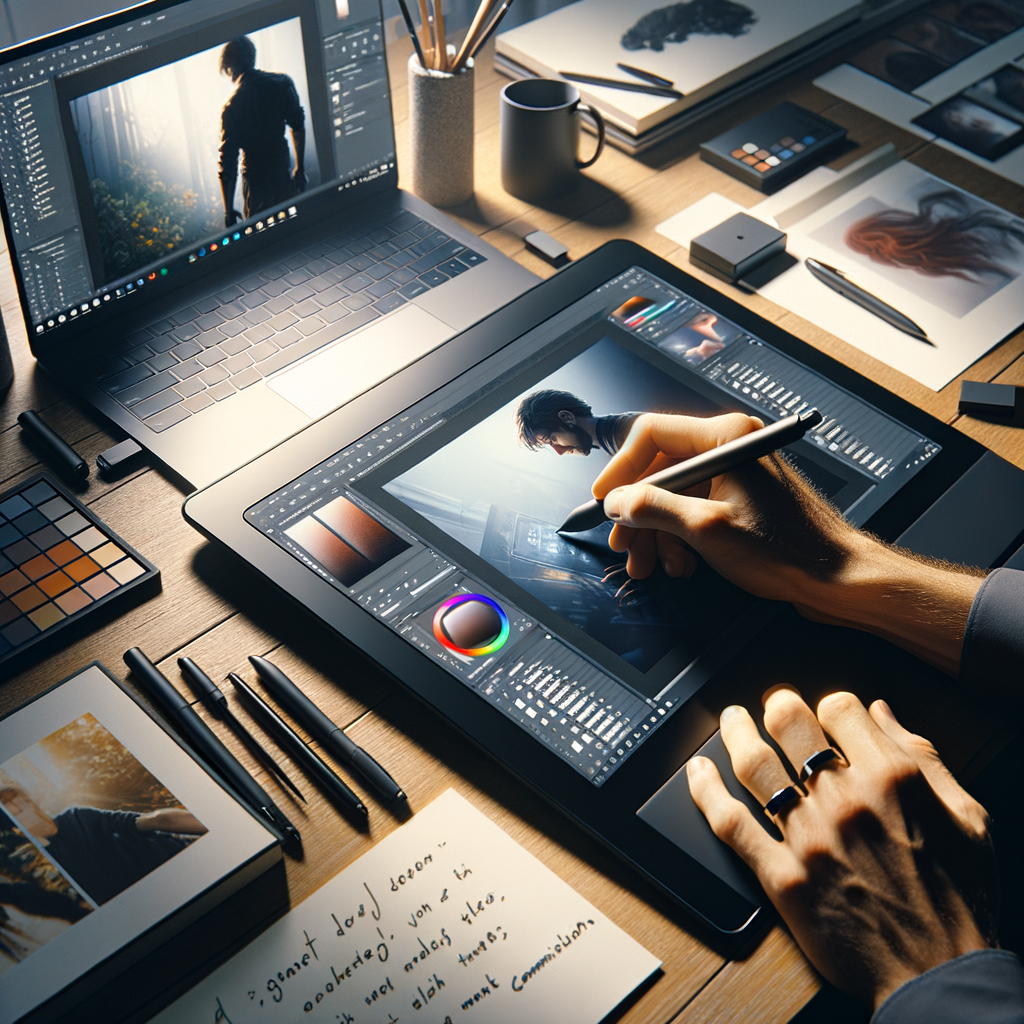Validate Features Without Prototypes: A Buyer’s SharePro Playbook
I show how commissioning concept art on SharePro validates features, wins stakeholder buy-in, and slashes prototype costs with a clear step-by-step buyer’s playbook.
Validate Features Without Prototypes: My SharePro Concept Art Playbook
I used to think the only credible way to validate a new feature was to build an interactive prototype. Then I started commissioning concept art on SharePro Marketplace and discovered I could answer the same stakeholder questions faster, cheaper, and with far less risk. In this playbook, I walk through exactly how I use concept art to clarify complex ideas, surface hidden assumptions, and secure stakeholder buy-in long before code or high-fidelity prototypes are on the table.
The core idea is simple. Most early decisions are visual decisions in disguise, and they hinge on clarity more than interactivity. Concept art translates fuzzy requirements into concrete scenes, states, and moments that people can react to. Instead of spending weeks on clickable flows that still leave room for interpretation, I put a carefully crafted illustration or composite in front of decision-makers and watch the conversation shift from opinion to evidence.
When a visual is specific, the feedback becomes specific. Executives point to the placement of a control and ask how it scales to mobile. Sales leaders question if the status badge will conflict with a partner logo. Engineers immediately see the implications for edge cases and data states. Because concept art freezes a moment in time, stakeholders critically evaluate what matters, not how a prototype feels. I capture their reactions, prioritize the themes, and turn that into a clear validation outcome without burning cycles on interactivity.

Here is the playbook I follow. I start by writing a single validation objective and the decisions I need to unlock. I pull reference screenshots, brand elements, and competing patterns. I draft a one-page brief, then pick a concept artist on SharePro whose portfolio matches the mood and level of fidelity I want. Together we explore one to three variations of the core moment, annotating key states and constraints. I test the images with stakeholders and a small user sample, collect structured feedback, and commission a final pass that resolves major questions. I then distill the outcomes into requirements, risks, and success metrics, ready for design and engineering to execute with confidence.

Why I Reach For Concept Art Before Prototypes
For early decision-making, speed beats polish and clarity beats clickability. Commissioned concept art is fast to produce, easy to iterate, and surprisingly persuasive because it delivers the essence of a feature without the distractions of motion and micro-interaction. When I am exploring new surfaces, layouts, or content hierarchies, a still frame is enough to spot friction, misaligned expectations, and scope creep. It also costs materially less than prototyping at high fidelity, so I can afford more divergent exploration up front.
Another advantage is fidelity control. With prototypes, stakeholders often fixate on the wrong details and infer that the design is further along than it is. Concept art keeps the conversation at the right altitude. I can request a looser style to emphasize exploration or a tighter, brand-accurate composite when I need to win a go or no-go decision. In either case, the art grounds the debate in something everyone can see, which reduces ambiguity and speeds alignment.
Concept art also scales well across audiences. I can put the same image in a board deck for executives, a figjam in a team workshop, and a lightweight survey for customers. Because the medium is universal, I avoid the tooling gap that sometimes excludes non-designers from prototype reviews. That inclusivity raises the signal quality and helps me spot objections earlier.
How I Write A Brief That Validates Decisions
My brief begins with the business moment, not the screen. I describe the user, the context, and the decision I need to validate, such as whether an upsell belongs in the checkout flow or if a real-time badge belongs on a crowded card. Then I list the specific unknowns that concept art must make visible, like how the component behaves when there are two promotions, what happens at narrow widths, and how the brand voice reads in a high-pressure moment. I attach brand tokens, sample data, and references to competing patterns so the artist can build on familiar elements.
I am explicit about constraints, because constraints drive useful art. I call out the grid, the minimum tappable area, the safe zones for accessibility, and any legal copy that must exist. I identify the states I want illustrated, such as default, success, and error, and I clarify whether the tone should be aspirational or system-accurate. When the brief explains the job the art is doing, the artist can propose smarter variations that test real trade-offs.
For deliverables, I prefer layered files so I can annotate, rearrange, or mask elements during review. I state the resolution, background preferences, and the format for quick sharing, such as flattened PNGs for slides and layered files for deeper analysis. Finally, I outline usage rights and confidentiality expectations, which on SharePro Marketplace are set per project and should be aligned before work starts.
Choosing The Right Artist On SharePro Marketplace
SharePro Marketplace is effective because I can filter by style, niche, budget, and turnaround time while reviewing portfolios that showcase exactly how artists solve visual problems. I look for evidence that the artist can convey interface logic, not just create beautiful images. If a portfolio shows attention to states, hierarchy, and systems thinking, I know the artist can help me validate decisions rather than just decorate them.
I message shortlists with my one-page brief to gauge fit, schedule, and communication style. I ask how they handle variations, how they prefer to receive feedback, and what a typical revision cycle looks like. Fast, clear communicators who can articulate trade-offs become long-term partners in my validation process. I confirm pricing, milestones, and rights in the SharePro project terms to prevent surprises and ensure the final images can be used in stakeholder materials.
For timelines, I often commission a quick exploration pass in two to three days, followed by a refinement pass after feedback. If I need multiple directions in parallel, I split the budget across two artists with distinct styles. Comparing two independent interpretations surfaces blind spots and helps me converge on a stronger direction with more confidence.
Running Fast, Structured Feedback Loops
Once I have first-pass images, I frame the review around decisions, not taste. I ask stakeholders what the art makes easier, what it makes harder, and what must be true for the design to succeed. I capture concrete observations, such as readability at small sizes or the cognitive load of competing callouts. Because concept art presents a single clear moment, people notice the spacing, density, and copy tone in ways they often miss in clickable prototypes.
When I want broader validation, I show two or three variants to a small customer panel and collect quick reactions with targeted prompts. I ask which version best communicates the benefit, which element draws the eye first, and what seems risky or confusing. Even a dozen responses can reveal consistent preferences and language that later shapes microcopy and onboarding. I keep the survey short and the task realistic so the feedback reflects actual decision-making rather than lab behavior.
Stakeholder buy-in is a by-product of this structure. By the time I present a recommendation, the visual trail shows how we explored options, what the audience preferred, and why the proposed direction solves the stated problem. The clarity of the concept art reduces abstract debate and surfaces the remaining real risks, which makes approval faster and more predictable.
Converting Concept Art Into Executable Requirements
After validation, I annotate the images with acceptance criteria. I note critical measurements, content rules, and state transitions that must be honored in implementation. I flag optional flourishes as stretch goals and document dependencies that affect feasibility, such as data freshness or third-party content. Engineers appreciate that the art already clarifies hierarchy and density, so we can focus our discussions on system constraints and edge cases.
If the concept revealed a new component, I specify variants and tokens upfront so the design system team can plan for integration. I capture copy decisions in a small lexicon and link it to the art for context. This bundle of visual evidence and structured requirements shortens handoff meetings because the visuals already align the team around what good looks like.
The Cost And ROI Math I Use
In my experience, a small concept art engagement on SharePro Marketplace often lands in the same range as a single day of senior design time, yet it can replace one to two weeks of prototype effort when the goal is alignment rather than usability at scale. I track ROI by the decisions unblocked per dollar spent and the risk retired per sprint. When a single image eliminates a risky direction or cements stakeholder conviction, the savings in rework and delay are immediate.
One recent initiative required deciding whether to surface a live status badge in a crowded dashboard card. Two rounds of concept art cost a fraction of a high-fidelity prototype and revealed that the badge competed with a critical number at certain densities. We altered the placement, adjusted the color, and added a subtle motion cue for live states. The team avoided building a dead-end interaction and shipped a cleaner solution with greater confidence.
Mistakes I Avoid When Commissioning Concept Art
The most common mistake is treating concept art like a finished spec. I always label images as validation artifacts and keep the conversation oriented toward decisions. Another pitfall is cramming too many questions into one image, which dilutes the feedback. I prefer multiple focused frames that each answer a specific unknown. Too little context is risky as well; without realistic sample data, the art can paint an optimistic picture that hides hard problems.
I also avoid briefing artists without showing real constraints. If an artist cannot see the grid, the content patterns, or the access rules that govern the surface, their best work might still miss the mark. Finally, I never skip usage rights and confidentiality. On SharePro Marketplace, I ensure the project terms explicitly cover presentation use, internal distribution, and any public sharing I may later want to do.
A Mini Case Study From My Playbook
I needed to validate an in-checkout upsell for a subscription product without torpedoing conversion. My objective was to test whether a contextual add-on card could raise average order value while maintaining clarity and trust. I briefed a SharePro concept artist with the brand tokens, the checkout grid, the legal copy, and two competing patterns from the market. The first exploration pass produced a bold variant with a large image and a subtle variant that prioritized copy and a guarantee badge.
Stakeholders initially favored the bold version, but a quick customer check revealed that the image crowded the primary price and distracted from the CTA. The subtle version, paired with a risk-reversal line and a calm color, tested better. We commissioned a second pass that refined spacing, ensured accessibility contrast, and demonstrated error states when inventory was unavailable. Armed with those images, the leadership team approved the direction and authorized build. We shipped the feature with minor tweaks and monitored conversion, seeing a lift in attach rate without harming checkout completion.
Legal And Ethical Considerations On SharePro Marketplace
I treat concept art like any other commissioned asset. Before work begins, I align on licensing, scope of use, attribution, and confidentiality, referencing the project terms inside SharePro Marketplace. If the art will appear in investor decks or public teasers, I make sure the license covers that use. When sensitive information is involved, I keep details private to the project workspace and use anonymized data in the visuals. Clear terms and respectful collaboration keep the relationship strong and the process repeatable.
Conclusion
Concept art on SharePro Marketplace gives me a fast, credible way to validate feature decisions, rally stakeholders, and cut prototype costs by making the right questions visible. By pairing a tight brief with the right artist and a structured feedback loop, I turn still images into confident decisions and clear requirements, all before a single screen is built.
Blog Article Tags
concept art product validation prototyping sharepro marketplace commissioning stakeholder buy-in feature prioritization ux research requirements gathering visual storytellingMore Articles
Maximizing Your Reach: Effective Social Media Strategies for Indie Creators - Discover actionable social media strategies for indie creators to engage fans, grow your audience, and increase support across disciplines.
How Using SharePro Marketplace Ensures Quality and Reliability in Your Service Purchases - Learn how SharePro Marketplace's vetting and buyer protections maintain high standards and reliability, letting you confidently buy quality services.
Unlocking Rapid Business Growth: How Hire Growth Hackers Accelerate Your Market Reach - Explore how hiring growth hackers can rapidly scale your business, boost customer acquisition, and expand market reach using innovative, tailored strategies.
Transform Your Property Listings with Stunning Drone Videography to Accelerate Sales - Discover how drone videography elevates property listings, showcasing features uniquely to engage buyers and speed up real estate sales.
Transform Your Brand Storytelling with Custom Character Animations - Elevate your brand narrative and engage your audience with bespoke character animation. Discover how visual storytelling on SharePro Marketplace can drive conversions.


